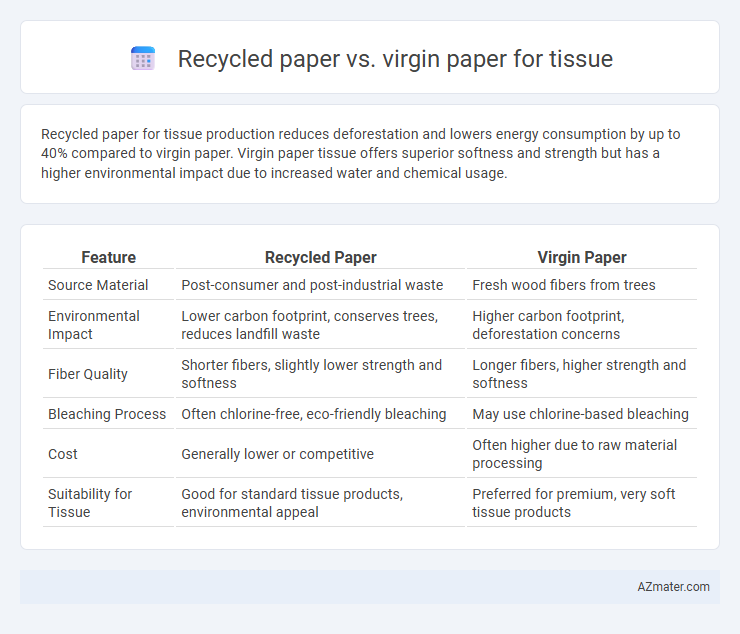Recycled paper for tissue production reduces deforestation and lowers energy consumption by up to 40% compared to virgin paper. Virgin paper tissue offers superior softness and strength but has a higher environmental impact due to increased water and chemical usage.
Table of Comparison
| Feature | Recycled Paper | Virgin Paper |
|---|---|---|
| Source Material | Post-consumer and post-industrial waste | Fresh wood fibers from trees |
| Environmental Impact | Lower carbon footprint, conserves trees, reduces landfill waste | Higher carbon footprint, deforestation concerns |
| Fiber Quality | Shorter fibers, slightly lower strength and softness | Longer fibers, higher strength and softness |
| Bleaching Process | Often chlorine-free, eco-friendly bleaching | May use chlorine-based bleaching |
| Cost | Generally lower or competitive | Often higher due to raw material processing |
| Suitability for Tissue | Good for standard tissue products, environmental appeal | Preferred for premium, very soft tissue products |
Introduction: The Debate on Recycled vs Virgin Paper for Tissue
Recycled paper tissue is made from post-consumer waste, reducing the need for virgin wood pulp and lowering environmental impact through decreased deforestation and energy consumption. Virgin paper tissue, derived from fresh wood fibers, offers higher strength and softness but involves greater resource use and carbon emissions. The debate centers on balancing sustainability with product quality, driving innovations in recycled tissue manufacturing to close performance gaps.
Environmental Impact: Recycled vs Virgin Tissue Paper
Recycled tissue paper significantly reduces environmental impact by minimizing deforestation, saving water, and lowering energy consumption compared to virgin tissue paper. Virgin tissue production requires cutting down large quantities of trees, contributing to habitat loss, increased carbon emissions, and higher water usage. Choosing recycled tissue paper supports sustainability by reusing fibers and reducing landfill waste, making it a more eco-friendly option.
Raw Material Sourcing and Sustainability
Recycled paper for tissue production relies on post-consumer and post-industrial waste, significantly reducing the demand for virgin pulp derived from trees, which conserves forests and decreases deforestation rates. Virgin paper requires extensive logging of softwood and hardwood fibers, resulting in higher carbon emissions and greater water consumption during raw material processing. Sustainable sourcing of recycled fibers supports circular economy principles, lowers landfill waste, and minimizes environmental footprint compared to the intensive natural resource extraction needed for virgin fiber production.
Production Process and Resource Consumption
Recycled paper for tissue production involves reprocessing used paper fibers through de-inking, cleaning, and refining, significantly reducing the need for virgin wood pulp and lowering water and energy consumption by up to 30%. Virgin paper production relies on processing fresh wood pulp from trees, which requires intensive bleaching, pulping, and higher energy inputs, contributing to increased deforestation and carbon emissions. The recycled paper process supports sustainable forestry by minimizing raw material extraction while maintaining tissue quality through advanced fiber recovery technologies.
Energy and Water Usage Comparison
Recycled paper for tissue production consumes up to 45% less energy and reduces water usage by approximately 40% compared to virgin paper, making it a more sustainable choice. Virgin paper requires extensive processing from raw wood pulp, which significantly increases both energy consumption and water demand. Switching to recycled fibers minimizes environmental impact through efficient manufacturing processes and resource conservation.
Tissue Paper Quality: Strength, Softness, and Performance
Tissue paper made from virgin fibers generally exhibits superior strength and softness compared to recycled paper, as virgin pulp maintains longer fibers that enhance durability and absorbency. Recycled tissue often faces challenges in performance due to fiber shortening and the presence of contaminants, which can reduce overall softness and tensile strength. Advanced processing technologies, such as enzymatic treatments and fiber refining, aim to improve recycled tissue quality, but virgin fiber products typically remain the benchmark for premium tissue paper performance.
Cost Analysis: Economic Considerations for Manufacturers and Consumers
Recycled paper for tissue production generally offers cost advantages due to lower raw material expenses, reduced energy consumption, and decreased landfill fees, which can lead to more competitive pricing for manufacturers. Virgin paper, derived from fresh wood pulp, involves higher costs associated with resource extraction and processing but often yields superior strength and softness, appealing to premium market segments willing to pay a premium. For consumers, tissues made from recycled paper typically provide a more economical option without significant compromise in quality, influencing purchasing decisions based on budget and sustainability preferences.
Health and Safety Concerns in Recycled and Virgin Tissue Paper
Recycled tissue paper may contain traces of contaminants such as inks, adhesives, and residues from previous use, potentially causing skin irritation or allergic reactions in sensitive individuals. Virgin tissue paper, produced from fresh pulp, generally offers higher purity and lower risk of chemical contaminants, making it a safer choice for hygienic applications. Regulatory standards and certifications, such as FSC and EPA guidelines, ensure both recycled and virgin tissues meet strict health and safety requirements for consumer use.
Market Trends and Consumer Preferences
The market for recycled paper tissue is experiencing significant growth due to increasing consumer demand for sustainable and eco-friendly products, driven by heightened environmental awareness and stricter regulations on deforestation. Virgin paper tissue maintains a steady market share because of its perceived superior softness and strength, appealing to premium segments such as luxury hotels and healthcare facilities. Innovations in recycling technology are improving the quality of recycled tissue, narrowing the performance gap and expanding its acceptance among mainstream consumers.
Future Outlook: Innovations in Sustainable Tissue Paper Production
Emerging technologies in sustainable tissue paper production emphasize advanced recycling methods and bio-based fibers to reduce reliance on virgin pulp. Innovations such as enzyme treatments and nanocellulose integration enhance the strength and softness of recycled paper, closing the quality gap with virgin tissue. Market trends point to increased adoption of circular economy practices, driven by consumer demand and stricter environmental regulations, positioning recycled tissue paper as a key component in the future of sustainable hygiene products.

Infographic: Recycled paper vs Virgin paper for Tissue
 azmater.com
azmater.com